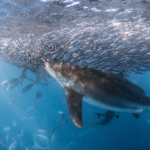

Searching for Fish Yields Insights into Gulf Stream’s Whims
Article By: Tony Bartelme | Originally posted: September 5, 2018 | Please click here for original article.
The Gulf Stream is a migratory highway for tuna, dolphinfish and billfish, so commercial and sports fishermen often turn to ocean forecasters to give them an edge.
Roffer’s Ocean Fishing Forecasting Service is one of these consultants.
“In springtime, the Gulf Stream is the conveyor belt that allows fish to move northeast,” said Matthew Upton, the company’s president. “You can catch them most of the summer depending on where the Gulf Stream is located, but coming back they may be way offshore (outside the Gulf Stream) or inshore. It changes all the time.”
The current’s reach is surprising to many people. One time a client had an unusual question: If they released a loved one’s ashes in the Gulf Stream off Georgetown, where would the ashes go?
Upton said they were able to show they would drift northeast and then over toward England.
Upton said a gyre — an area of circulating water — off Charleston is a popular fishing spot. “But it varies from day to day. When one eddy moves away, another will form.”
Upton is well aware of studies about the Gulf Stream’s flow slowing down.

Above: Matthew Upton, president of Roffer’s Ocean Fishing Forecasting Service. Photo courtesy of Matthew Upton/Provided
Please click HERE to read article on our website now!
A Powerful Current Just Miles from SC is Changing
Article By: Tony Bartelme | Originally posted: September 5, 2018 | Please click here for original article.
Off South Carolina, the ocean suddenly changes color, from green to deep blue. You’re in the Gulf Stream now, in warm and salty water from the tropics, with swordfish, tuna and squid, in a current so strong that it lowers our sea level.
Benjamin Franklin would learn about this current’s force. He was a Colonial postmaster before the American Revolution, and he’d noticed British mail ships were slow, much slower than other merchant ships. Why?
He mentioned this to his cousin, Timothy Folger, a ship captain who’d hunted whales off New England. Ah, yes, that current off the East Coast, Folger told Franklin. Any fishermen worth their nets cut in and out to make better time — the whalers had even warned the mail ships to steer clear. But the Brits “were too wise to be counseled by American fishermen.”
A map might help, and so they made a chart of this “Gulf Stream” from Florida toward Europe. It was one of the first maps to document its tremendous reach.
Map or no map, the British mail ships still bucked the current, and letters still arrived more slowly than they should have. But there it was now, on paper, a massive river in the sea, a swift flow with mysteries scientists have only begun to solve.
The Gulf Stream is one of the mightiest currents on Earth. It moves at a rate of 30 billion gallons per second, more than all of the world’s freshwater rivers combined. On its way, it hauls vast amounts of heat; a hurricane that twists into it gets a blast of fuel. It’s a highway for migrating fish and a destination for deep-sea fishermen. It courses through an area that oil companies want to probe; an oil spill in the Gulf Stream would spread far and wide.
Though just 50 miles from Charleston, the Gulf Stream has so much momentum it tilts the sea level down like a seesaw. If you could walk on water, a trek from the Gulf Stream to Folly Beach would go downhill 3 to 5 feet. Put another way, without the Gulf Stream whisking all that water past us, our tides would be at least 3 feet higher.In 2009, the Atlantic’s system of currents, including the Gulf Stream, slowed by 30 percent in a matter of weeks. Sea levels in New England also rose 5 inches above normal. Scientists were stunned. The currents regained their strength a year later, but scientists wondered: Was this a blip? Has global warming somehow gummed up the currents? If so, what’s next?

Above: Currents in the Gulf of Mexico join ones from the Caribbean near Florida to create the Gulf Stream. NASA created this visualization from satellite data. Courtesy: NASA/Goddard Space Flight Center Scientific Visualization Studio.
Please click HERE to read article on our website now!
How could the Gulf Stream affect oil spills?

Computer-generated simulations show oil spills off the southeast coast could travel fast in the Gulf Stream or hit beaches depending on spill sites. (Simulation by J. Emory Parker/The Post and Courier). In what’s thought to be a first for a media organization, The Post and Courier used government programs to simulate more than 1,000 oil spills through this dynamic area, discovering that spills would wreak havoc for hundreds of miles and make cleanup nearly impossible. The Gulf Stream in effect becomes a high-velocity pump. Simulations show spills devastating beaches in the Carolinas, with North Carolina’s Outer Banks especially vulnerable. The simulations are part of a larger look at the Gulf Stream and how it affects everything from weather in Charleston and London to sea levels on the East Coast. If it slows down, as some scientists fear, many East Coast cities could suddenly see greater sea rise trends than predicted. Video Courtesy: Post and Courier | YouTube
Please click HERE to watch video on our website now!
Updated Photos

Congratulations to ROFFS™ Client Brian Strauss (Gigabyte), released 18 white marlin out of Cape May NJ.

Great fishing trip for ROFFS™ client Dustin Creed and friends out of Panama City, FL.

ROFFS™ Client Darrin Brown (Catchin’ Grief) caught two whites out of Ocean City MD.

ROFFS™ Client Jeremy Bendler and his son Jake Bendler (Schedule Sea) had a great day offshore Hatteras with a sailfish release and 40 lb. Wahoo.
Please click HERE to view recent 2018 photos on our website now!
Please click HERE to view our recently updated 2018 Winners List on our website now!
Backlash? Feedback?

As always, please send comments & feedback on Fishy Times newsletter content directly to us at feedback@roffs.com.
If you do not want to wait for our next Fishy Times newsletter, please visit us in the meantime to get all your fishing news using the social media/web links below. Safe and successful fishing until next time!






